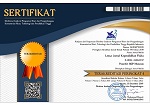Pengembangan Bata Ringan Berbahan Dasar Limbah Pengolahan Emas Tradisional dengan Penguat Eceng Gondok
DOI:
https://doi.org/10.33394/j-lkf.v6i2.1144Keywords:
Light Brick, Compressive Strength, DensityAbstract
[Title: Development of Lightweight Brick Based on Traditional Gold Processing Waste with Water Hyacinth Booster]. Research has been carried out on the manufacture of light brick made from gold processing waste with water hyacinth filler. The study was carried out by varying the direction of water hyacinth fiber as filler in light brick making. The direction of the filler is arranged in a horizontal, orthogonal and random direction. In each filler direction, the percentage variation of water hyacinth is arranged with the volume fraction 0%, 15%, 30%, 45%, 60%, from the total volume of the amount of light brick. The test results show that in the horizontal fiber direction the compressive strength is (2.43; 0.25; 0.54; 0.24; 0.50) MPa with a density (1.62; 1.34; 1.58; 1.42; 1.25) gr /cm3. In orthogonal direction the compressive strength was (2.43; 0.26; 0.80; 0.63; 0.77) MPa with density (1.62; 1.42; 1.49; 1.53; 1.42) gr/cm3. While in the random direction the compressive strength was (2.43; 0.73; 0.69; 0.59; 0.65) MPa with a density (1.62; 1.20; 1.41; 1.13; 1, 20) gr/cm3. From these data by comparing with previous studies, the most stable compressive strength and density values are formed in orthogonal directions. While the density value is most formed in random direction. In all directions the compressive strength and stable density were formed in the 60% volume of filler. The test results show that the light brick that is formed into the category is very light (entered in 0.6 - 1.6 gr/cm3 range) and floating in water, with medium compressive compressive strength.References
Abolagba I. dan Osuji S. (2017). “Assessment of Manufactured Sand in Concrete
Produced with Palm Kernel Shells as Coarse Aggregateâ€. International Journal of Science and Research (IJSR)ISSN (Online): 2319-7064.
Hendra, (2011).“Pemanfaatan Eceng Gondok (Eichornia crassipes) untuk Bahan Baku Briket sebagai Bahan Bakar Alternativâ€. Jurnal Penelitian Hasil Hutan, 2011 - ejournal.forda-mof.org.
Hunggurami, E., et.al., (2014). “Studi Eksperimental Kuat Tekan dan Serapan Ari Bata Ringan Cellular Lightweight Concrete dengan Tanah Putih sebagai Agregatâ€. Jurnal Teknik Sipil Vol. III, No. 2, September 2014.
Kristanti, N., Tansajaya, A. (2008). “Studi Pembuatan Cellular Lightweight Concrete (CLC) dengan Menggunakan Beberapa Foaming Agentâ€. Thesis. Universitas Kristen Petra. Surabaya.
Pangga Dwi, Sabda Dwi. (2016). “Pemisahan Emas pada Batuan Alam Pertambangan Tradisional Sekotong dengan Metode Ramah Lingkungan. Mataram: Semnas PKPP IKIP Mataram.
......... (2018). “Analisis Pengaruh Arah Serat Eceng Gondok Terhadap Kuat Tekan dan Densitas Bata Ringan†Universitas Islam Madursa: Prosiding, Semnas Nacomse, 22 September 2018.
Pratama, willy, dkk. (2015). “Perbandingan Kuat Tekan dan Tegangan-Regangan
Bata Beton Ringan dengan Penambahan Mineral Alami Zeolit Alam Tertahan Saringan No.80 (0,180mm) dan Tertahan Saringan No.200 (0,075mm)†Rekayasa Sipil, ISSN 1978-5658, Volume 9, No.3 – 2015.
Sagit, Nugraha. (2010). “Penerapan Bentuk Desain Rumah Tahan Gempaâ€. ISSN 1907–8536. Volume 5 Nomor 1 Juli 2010.
Suarnita Wayan, (2010). “Karakteristik Beton Ringan dengan Menggunakan Tempurung Kelapa sebagai Bahan Pengganti Agregat Kasar. SMARTek, SIPIL’MESIN ’ARSITEKTUR ’ELEKTRO.
Suzaeni. (2013). Analysis Comparison Of Lightweight Concrete Wall With
M-System Wall. Extrapolasi Jurnal Teknik Sipil Untag Surabaya, 6(1), 8 – 17.
Downloads
Published
How to Cite
Issue
Section
License
Authors who publish with Lensa: Jurnal Kependidikan Fisika agree to the following terms:
- For all articles published in Lensa: Jurnal Kependidikan Fisika, copyright is retained by the authors. Authors give permission to the publisher to announce the work with conditions. When the manuscript is accepted for publication, the authors agree to automatic transfer of the publishing right to the publisher.
- Authors retain copyright and grant the journal right of first publication with the work simultaneously licensed under a Creative Commons Attribution-ShareAlike 4.0 International License that allows others to share the work with an acknowledgment of the work's authorship and initial publication in this journal.
- Authors are able to enter into separate, additional contractual arrangements for the non-exclusive distribution of the journal's published version of the work (e.g., post it to an institutional repository or publish it in a book), with an acknowledgment of its initial publication in this journal.
- Authors are permitted and encouraged to post their work online (e.g., in institutional repositories or on their website) prior to and during the submission process, as it can lead to productive exchanges, as well as earlier and greater citation of published work (See The Effect of Open Access).

This work is licensed under a Creative Commons Attribution-ShareAlike 4.0 International License.



